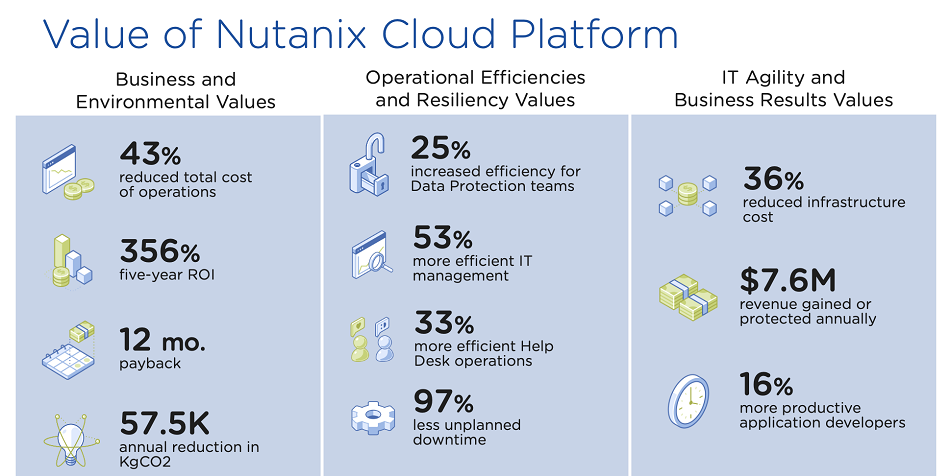A recent IDC study, sponsored by Nutanix, accessed the business value of hyperconverged infrastructure (HCI)-based Nutanix Cloud Platform (NCP) used by eight Nutanix customers. The research firm calculated that, on average, each of the customers saw a $5.9 million benefit annually compared to their previous infrastructure solution.
Dispersed across three global regions, the companies surveyed had migrated from three-tier data center infrastructure to HCI using the Nutanix Cloud Platform. They ranged in size from $50 million to $11.5 billion in annual revenue and averaged 836 IT staff and 421 business applications.
In the Business Value of Nutanix Cloud Platform report, IDC projects that companies interviewed for the report are on track to five-year discounted benefits worth an average of $20.9 million per organization through improved business operations and IT team and end-user productivity gains. These benefits compare with total five-year discounted costs of $4.6 million per organization.
“These levels of benefits and investment costs are projected to result in an average ROI of 356% with a break-even point occurring in 12 months,” explained Greg White, senior director of solutions marketing at Nutanix.
The report also stated that unplanned downtime dropped by 97%, IT management was streamlined, and help desk, data protection and application development capabilities improved.
The essence of end user computing (EUC) operations is a fluid, almost abstract interaction between the underlying infrastructure and everyday users. This requires the architecture to be agile and scalable, with a control and management plane that isn’t overly complex.
By virtualizing compute, storage, and networking, HCI enables IT teams to quickly configure and provision these functions in software, rather than requiring them to deploy multiple, purpose-built hardware appliances. Software instances share clusters of cost-effective commodity hardware nodes that can reside on-premises, in the public cloud, at the edge, or in a hosted, managed or public cloud data center. Enterprises can easily scale their deployments just by adding nodes to a cluster.
Use of HCI for Databases and Critical Apps
Software-defined infrastructures like HCI are widely used for IT modernization. Among the enterprise companies included in the Nutanix-sponsored IDC study, more than 70% reported having already moved workloads from legacy storage-area network (SAN) and network-attached storage (NAS) systems to HCI, and 56% said they are running mission-critical workloads on it.
HCI was first used for virtual desktop infrastructure and such things as dev/test, Active Directory, DNS and file/print servers, according to White.
“Now HCI is being used for databases and business-critical applications on VMs [virtual machines] and containers,” White said.
“Companies evaluating how to achieve higher ROI and lower TCO can use this IDC report to see and quantify the value that is possible from migrating legacy systems to an HCI-based platform.”
IDC’s calculations of the business value of moving from legacy data center solutions to Nutanix Cloud Platform are shown in Figure 1. They account for company size, average number of VMs, nodes, and applications and databases.

Source: IDC Research, 2022
By deploying Nutanix software, organizations in the study lowered their infrastructure costs by reducing the number of physical servers they purchase, host, manage, power, and cool. The reduction impacted each organization's carbon footprint by an average of 57,500 kg of CO2 emissions per year. The study only looked at servers, so there is a potential to increase these savings by reducing other infrastructure requirements like storage and networking.
How is an HCI-based platform making a difference?
The benefits IDC respondents cited were wide-ranging. “One full-time employee can handle maybe 10x more compared with what we’d seen with three-tier architectures,” said one respondent. Another reported that with HCI, “End users are seeing increased uptime from having a more reliable infrastructure and less downtime for critical systems.”
Another company involved in the study explained how improved downtime contributes to an improved customer experience.
“A software-defined architecture supports self-service because we can automate everything and the network monitors itself,” the respondent said. “The uptime dramatically impacts our support resources and I feel comfortable redirecting them to other areas.”
Another benefit cited was a reduction of hardware.
“We reduced the data center footprint by about 48%,” the respondent stated. “If we were doing this with three-tier infrastructure, we’d have much more than the 120 nodes that we have now. I’d say that if we were replicating with a standard architecture, we’d be looking at more like 600 to 700 servers.”
The respondent said the company can now “restore hundreds of servers in minutes.”
Nutanix’s White believes that the compelling economic value proposition for a cloud platform built on HCI as a software-defined infrastructure of choice is just one of the many benefits that will capture the attention of companies that have yet to transition from legacy systems.
“The average of $7.6 million in additional annual revenue linked to the deployment of NCP by these companies in the study is significant,” he said.
“The study provides the hard numbers across various metrics to warrant the attention of decision makers in IT, lines of business, and executives in the C suite.”
Because of its software-defined simplicity and many operational, uptime, and IT productivity benefits, IDC expects HCI to continue on its upward growth trajectory. The researcher predicts that HCI revenues will increase yearly by about 11% and to reach $14.7 billion globally by 2024.
Editor’s note: Read the white paper based on the IDC study: “The Business Value of Nutanix Cloud Platform.”
Gene Knauer is a contributing writer who specializes in IT and business topics. He is also the author of Herding Goldfish: The Professional Content Marketing Writer in an Age of Digital Media and Short Attention Spans.
© 2023 Nutanix, Inc. All rights reserved. For additional legal information, please go here.




